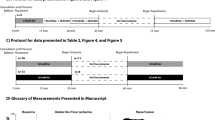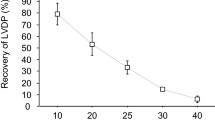Abstract
The roles of the Na+/H+ exchange system in the development and cessation of reperfusion induced ventricular arrhythmias were studied in the isolated perfused rat heart. The hearts were perfused in the working heart mode with modified Krebs Henseleit bicarbonate (KHB) buffer and whole heart ischemia was induced by a one-way ball valve with 330 beat/min pacing. Ischemia was continued for 15 min followed by 20 min of aerobic reperfusion (control). Amiloride (1.0mM), an inhibitor of the Na+/H+ exchange system, was added to the KHB buffer only during reperfusion (group B) or only during ischemic periods (group C). Electrocardiographic and hemodynamic parameters were monitored throughout the perfusion. Coronary effluent was collected through pulmonary artery cannulation and PO2, PCO2, HCO −3 and pH were measured by blood-gas analyzer.
The incidence of reperfusion induced ventricular arrhythmias was 100%, 100% and 0% in control, group B and group C, respectively. The mean onset time of termination of reperfusion arrhythmias was significantly shorter in group B than in control. PCO2 increased from 39.0±0.9 to 89.3±6.0 mmHg at the end of ischemia in control and from 40.6±0.4 to 60.5±5.8 in group C, the difference between groups was statistically significant. HCO −3 level decreased from 21.8±0.1 to 18.3±0.5 mmol/l in control, however, this decrease was significantly inhibited in group C (from 22.0±0.5 to 20.3±0.2). The increase in PCO2 and the decrease in HCO −3 in group B were similar over time to those observed in control. The decrease in pH produced by ischemia was marked in control (from 7.35±0.01 to 6.92±0.04) and group B (from 7.34±0.01 to 6.94±0.02), whereas a decrease in pH was significantly prevented in group C (from 7.34±0.01 to 7.15±0.04). There were no significant differences in PCO2, HCO −3 or pH among the three groups during reperfusion.
These experiments provide evidence that amiloride significantly prevented the incidence of reperfusion arrhythmias when added only during ischemia and significantly terminated reperfusion arrhythmias when added only during reperfusion. Amiloride may prevent a decrease in pH, due to alterations in PCO2 and/or HCO −3 . These changes in PCO2 and HCO −3 might be indirectly influenced by inhibition of the Na+/H+ exchange system via Cl−/HCO −3 exchange. The mechanism by which amiloride terminates reperfusion arrhythmias seems to involve electrophysiological effects which were not directly addressed in this experiment.
Similar content being viewed by others
References
Allen DG, Eisner DA, Lab MJ, Orchard CH: The effects of low sodium solutions on intracellular calcium concentration and tension in ferret ventricular muscle. J Physiol 345: 391–407, 1983
Carafoli E: The homeostasis of calcium in heart muscle. J Mol Cell Cardiol 17: 203–212, 1985
Steenbergen C, Murphy E, Watts JA, London RE: Correlation between cytosolic free calcium, contracture, ATP and irreversible ischemic injury in perfused rat heart. Circ Res 66: 135–146, 1990
Nayler WG, Panagiotopoulos S, Elz JS, Daly MJ: Calcium-mediated damage during post-ischemic reperfusion. J Mol Cell Cardiol 20 (Suppl 2): 41–54, 1988
Reuter H, Seitz N: The dependence of calcium efflux from cardiac muscle on temperature and external ion composition. J Physiol 195: 451–470, 1968
Eisner DA, Lederer WJ: Na−Ca exchange: Stoichiometry and electrogenicity. Am J Physiol 248: C189-C202, 1985
Chapman RA, Coray A, McGuigan JAS: Sodium/Calcium exchange in mammalian ventricular muscle: A study with sodium-sensitive micro-electrodes. J Physiol 343: 253–276, 1983
Kirby MS, Orchard C, Boyett MR: The control of calcium influx by cytoplasmic calcium in mammalian heart muscle. Mol Cell Biochem 89: 109–113, 1989
Barry WH, Rasmussen CAF Jr, Ishida H, Bridge JHB: External Na-independent Ca extrusion in cultured ventricular cells. Magnitude and functional significance. J Gen Physiol 88: 393–411, 1986
Bersohn MM, Philipson KD, Fukushima JY: Sodium-calcium exchange and sarcolemmal enzymes in ischaemic rabbit heart. Am J Physiol 248: C288-C295, 1982
Daly MJ, Elz JS, Nayler WG: Sarcolemmal enzymes and Na+−Ca+ exchange in hypoxic, ischaemic and reperfused rat hearts. Am J Physiol 247: H237-H243, 1984
Mochizuki S, MacLeod KT: The effects of hypoxia on cytoplasmic Ca2+ during low Na exposure in isolated cardiac myocytes from guinea-pig. J Physiol 446: 334, 1991
Piwnica-Worms D, Jacob R, Horres CR, Lieberman M: Na/H exchange in cultured chick heart cells. J Gen Physiol 85: 43–64, 1985
Frelin C, Vigne P, Lazdunski M: The role of the Na+/H+ exchange system in the regulation of the internal pH in cultured cardiac cells. Eur J Biochem 149: 1–4, 1985
Pierce GN, Philipson KD: Na+−H+ exchange in cardiac sarcolemmal vesicles. Biochim Biophys Acta 818: 109–116, 1985
Luzdunski M, Frelin C, Vigne P: The sodium/hydrogen exchange in cardiac cells: Its biochemical and pharmacological properties and its role in regulating internal concentrations of sodium and internal pH. J Mol Cell Cardiol 17: 1029–1042, 1985
Grinstein S, Rothstein A: Mechanisms of regulation of the Na+/H+ exchanger. J Membrane Biol 90: 1–12, 1986
Kaila K, Vaughan-Jones RD: Influence of sodium-hydrogen exchange on intracellular pH, sodium and tension in sheep cardiac Purkinje fibres. J Physiol 390: 93–118, 1987
Kim D, Cragoe EJ Jr, Smith TW: Relations among sodium pump inhibition, Na−Ca and Na−H exchange activities, and Ca−H interaction in cultured chick heart cells. Cirs Res 60: 185–193, 1987
Cala PM, Anderson SE, Cragoe EJ Jr: Na/H exchange-dependent cell volume and pH regulation and disturbances. Comp Biochem Physiol 90A: 551–555, 1988
Meno H, Jarmakani JM, Philipson KD: Developmental changes of sarcolemmal Na+/H+ exchange. J Mol Cell Cardiol 21: 1179–1185, 1989
Blatter LA, McGuigan JAS: Intracelluar pH regulation in ferret ventricular muscle. The role of Na−H exchange and the influence of metabolic substrates. Circ Res 68: 150–161, 1991
Meng HP, Lonsberry BB, Pierce GN: Influence of perfusate pH on the postischemic recovery of cardiac contractile function: Involvement of sodium-hydrogen exchange. J Pharmacol Exp Ther 258: 772–777, 1991
Khandoudi N, Bernard M, Cozzone P, Feuvray D: Intracellular pH and role of Na+/H+ exchange during ischaemia and reperfusion of normal and diabetic rat hearts. Cardiovasc Res 24: 873–878, 1990
Karmazyn M: Ischemic and reperfusion injury in the heart. Cellular mechanisms and pharmacological interventions. Can J Physiol Pharmacol 69: 719–730, 1990
Dennis SD, Coetzee WA, Cragoe EJ Jr, Opie LH: Effects of proton buffering and of amiloride derivatives on reperfusion arrhythmias in isolated rat hearts. Circ Res 66: 1156–1159, 1990
Karmazyn M: Amiloride enhances postischemic ventricular recovery: Possible role of Na+−H+ exchange. Am J Physiol 255: H608-H615, 1988
Neely JR, Liebermeister H, Battersby EJ, Morgan HE: Effect of pressure development on oxygen consumption by isolated rat heart. Am J Physiol 212: 804–814, 1967
Mochizuki S, Okumura M, Tanaka F, Sato T, Kagami A, Tada N, Nagano M: Ischemia-reperfusion arrhythmias and lipids: Effect of human high- and low-density lipoproteins on reperfusion arrhythmias. Cardiovasc Drug Ther 5: 269–276, 1991
Neely JR, Rovetto MJ, Whitmer JT, Morgan HE: Effects of ischemia on function and metabolism of isolated working rat heart. Am J Physiol 225: 651–658, 1973
MacLeod KT: Regulation and interaction of intracellular calcium, sodium and hydrogen ions in cardiac muscle. Cardioscience 2: 71–85, 1991
Kim D, Smith TW: Cellular mechanisms underlying calciumproton interactions in cultured chick ventricular cells. J Physiol 398: 391–410, 1988
Kaila K, Vaughan-Jones RD, Bountra C: Regulation of intracellular pH in sheep cardiac Purkinje fibre: Interactions among Na+, H+ and Ca2+. Can J Physiol Pharmacol 65: 963–969, 1986
Jennings RB, Reimer KA: The cell biology of acute myocardial ischemia. Annu Rev Med 42: 225–246, 1991
Renlund DG, Gerstenblith G, Lakatta EG, Jacobus WE, Kallman CH, Weisfeldt ML: Perfusate sodium during ischemia medifies post-ischemic functional and metabolic recovery in the rabbit heart. J Mol Cell Cardiol 16: 795–801, 1984
Tani M, Neely JR: Role of intracellular Na+ in Ca2+ overload and depressed recovery of ventricular function of reperfused ischemic rat hearts. Possible involvement of H+−Na+ and Na+−Ca2+ exchange. Circ Res 65: 1045–1056, 1989
Haigney MCP, Miyata H, Lakatta EG, Stern MD, Silverman HS: Dependence of hypoxic cellular calcium loading on Na+−Ca2+ exchange. Circ Res 71: 547–557, 1992
MacLeod KT: Effects of hypoxia and metabolic inhibition on the intracellular sodium activity of mammalian ventricular muscle. J Physiol 416: 455–468, 1989
Poole-Wilson PA, Tones MA: Sodium exchange during hypoxia and on reoxygenation in the isolated rabbit heart. J Mol Cell Cardiol 20 (Suppl 2): 15–22, 1988
Anderson SE, Murphy E, Steenbergen C, London RE, Cala PM: Na−H exchange in myocardium: Effects of hypoxia and acidification on Na and Ca. Am J Physiol 259: C940-C948, 1990
Murphy E, Perlman M, London RE, Steenbergen C: Amiloride delays the ischemia-induced rise in cytosolic free calcium. Circ Res 68: 1250–1258, 1991
Bountra C, Vaughan-Jones RD: Effect of intracellular and extracellular pH on contraction in isolated mammalian cardiac muscle. J Physiol 418: 163–187, 1989
Poole-Wilson PA, Cameron IR: Intracellular pH and K+ of cardiac and skeletal muscle in acidosis and alkalosis. Am J Physiol 228: 1305–1310, 1975
Duan J, Karmazyn M: Protective effects of amiloride on the ischemic reperfused rat heart. Relation to mitochondrial function. Eur J Pharmacol 210: 149–157, 1992
Cobbe SM, Poole-Wilson PA: The time of onset and severity of acidosis in myocardial ischaemia. J Mol Cell Cardiol 12: 745–760, 1980
Vanheel B, de Hemptinne A, Leusen I: Analysis of Cl−/HCO −3 exchange during recovery from intracellular acidosis in cardiac Purkinje strands. Am J Physiol 246: C391-C400, 1984
Mahnensmith RL, Aronson PS: The plasma membrane sodiumhydrogen exchanger and its role in physiological and pathophysiological processes. Circ Res 57: 773–788, 1985
Vanghan-Jones RD: Chloride activity and its control in skeletal and cardiac muscle. Phil Trans R Soc Lond B 299: 537–548, 1982
Meng HP, Pierce GN: Protective effects of 5-(N, N-dimethyl) amiloride on ischemia-reperfusion injury in hearts. Am J Physiol 258: H1615-H1619, 1990
Weiss RG, Lakatta EG, Gerstenblith G: Effects of amiloride on metabolism and contractility during reoxygenation in perfused rat hearts. Circ Res 66: 1012–1022, 1990
Kennedy RH, Berlin JR, Ng YC, Akera T, Brody TM: Amiloride: Effects on myocardial force of contraction, sodium pump and Na+/Ca2+ exchange. J Mol Cell Cardiol 18: 177–188, 1986
Marchese AC, Hill JA Jr, Xie PD, Strauss HC: Electrophysiologic effects of amiloride in canine Purkinje fibers: Evidence for a delayed effect on repolarization. J Pharmacol Exp Ther 232: 485–491, 1984
Satoh H, Hashimoto K: An electrophysiological study of amiloride on sino-atrial node cells and ventricular muscle of rabbit and dog. Arch Pharmacol 333: 83–90, 1986
Duff HJ, Brown E, Cragoe EJ, Rahmberg M: Antiarrhythmic activity of amiloride: Mechanisms. J Cardiovasc Pharmacol 17: 879–888, 1991
Duff HJ, Lester WM, Rahmberg M: Amiloride. Antiarrhytmic and electrophysiological activity in the dog. Circulation 78: 1469–1477, 1988
Kleyman TR, Cragoe EJ Jr: The mechanism of action of amiloride. Seminars in Nephrology 8: 242–248, 1988
DiPolo R, Beaugé L: The effect of pH on Ca2+ extrusion mechanism in dialyzed squid axons. Biochim Biophys Acta 688: 237–245, 1982
Author information
Authors and Affiliations
Rights and permissions
About this article
Cite this article
Mochizuki, S., Seki, S., Ejima, Ma. et al. Na+/H+ exchanger and reperfusion-induced ventricular arrhythmias in isolated perfused heart: possible role of amiloride. Mol Cell Biochem 119, 151–157 (1993). https://doi.org/10.1007/BF00926866
Issue Date:
DOI: https://doi.org/10.1007/BF00926866




